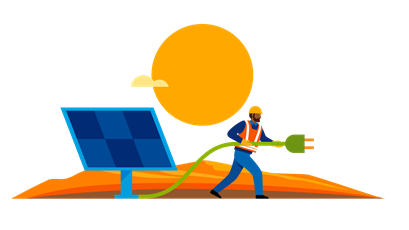alternative fuels
carbon utilization could open new pathways to renewable fuels
2 minute read | august 29, 2024
Renewable fuels are made from many different crops, including soybeans.
Biofuels have long been made from things like soybean oil and used cooking oil.
Now, emerging technologies could allow other feedstocks to be used.
Michelle Young is the renewable fuels R&D program manager at the Chevron Technical Center. Her team is on the hunt for new ways of making renewable fuels. One path they’re exploring is carbon utilization, which the International Energy Agency has named one of several paths to a lower carbon future.
To make renewable fuels, a catalyst—something that helps a chemical reaction—is often used to convert the starting material into a fuel. Sometimes, multiple catalysts are needed. Catalyst development is a key focus for Chevron, where scientists are working to both create new catalysts and modify existing ones.
For example, Chevron is currently exploring how to use novel catalysts to convert captured carbon dioxide (CO2) into sustainable aviation fuel, methanol and other lower carbon intensity fuels.
“We have been successfully making renewable fuels from crops like soybean oil and waste feedstocks like animal fats and used cooking oil,” said Young. “But breakthrough technologies can create renewable fuels from new sources like carbon dioxide and biomass such as algae and landfill waste.”
capturing potential
Renewable fuels can be made from organic matter, which contains carbon. As organic waste decomposes, it creates CO2 and methane. These can be used to develop renewable fuels.
CO2 has emerged as a promising feedstock because it’s so abundant and could be used for many different products.
the right mix
When CO2 is combined with hydrogen, one possible product is methane. Methane is the primary component of renewable natural gas (RNG), which often comes from dairies and landfills. New processes could use CO2, hydrogen and solar energy to produce a lower carbon methane that's compatible with RNG and that can be compressed into CNG. Both CNG and RNG can be used as transportation fuel.
The U.S. Department of Energy finds that, in most cases, RNG is pipeline-ready and fully interchangeable with conventional natural gas. This makes it possible to transport and use with existing vehicles and infrastructure.
Biology offers other possibilities for capturing CO2. Algae and some microbes naturally capture CO2 and convert it into oils, sugars and other molecules. Many of these products could someday be upgraded into transportation fuels via catalysts.

Michelle Young, the renewable fuels R&D program manager at the Chevron Technical Center, said that when it comes to renewable fuels, it’s all about finding the right combination of materials and processes.
what’s next
As technologies advance, lower carbon intensity fuels could become more available. With these new materials and processes, companies and consumers could someday be able to choose renewable fuels for daily use.
Walmart has already debuted a CNG engine for its heavy-duty vehicle fleet. Chevron-supplied CNG linked to RNG will help fuel these vehicles.
Chevron is working across industries to find feedstock solutions.
topics covered
related content
-

 chevron CEO talks growing production, efficient spending
chevron CEO talks growing production, efficient spendingemissions solutionsdecember 18, 2024
-

 biofuels can help maritime industry lower carbon intensity
biofuels can help maritime industry lower carbon intensityalternative fuelsnovember 08, 2024
-

 hydrogen project tour highlights expertise, role in energy market
hydrogen project tour highlights expertise, role in energy marketalternative fuelsnovember 04, 2024
-

 sun rises on solar energy operations
sun rises on solar energy operationsalternative fuelsseptember 13, 2024
chevron email updates
Subscribe to our newsletter to receive news and updates.




